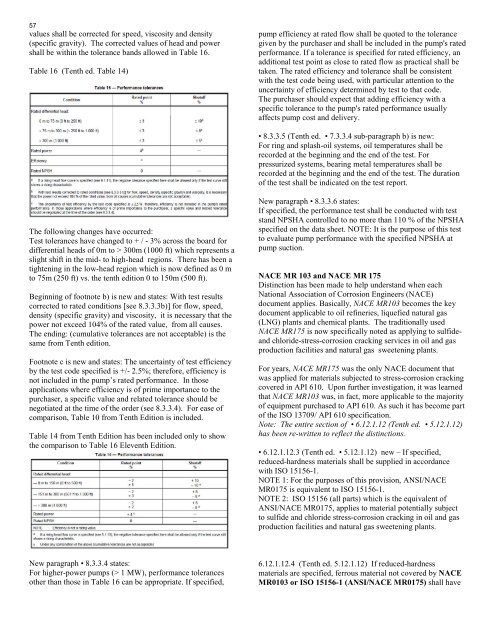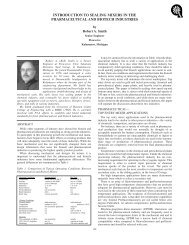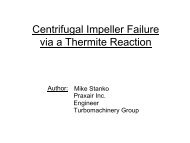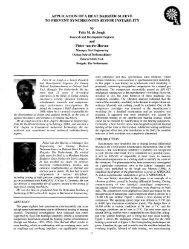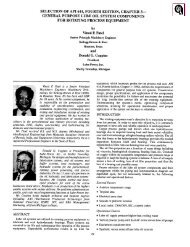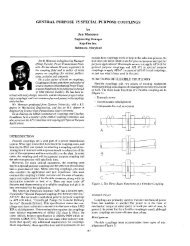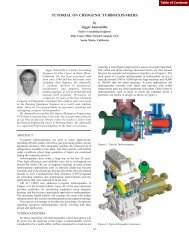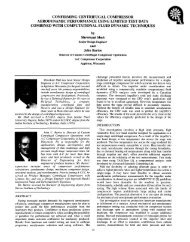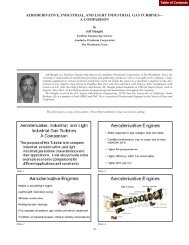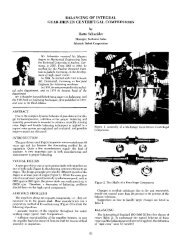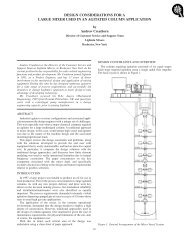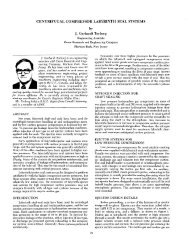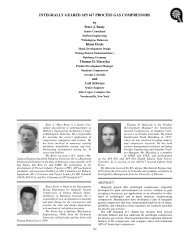ISO 13709 2nd Edition/ API 610 Eleventh Edition Highlights
ISO 13709 2nd Edition/ API 610 Eleventh Edition Highlights
ISO 13709 2nd Edition/ API 610 Eleventh Edition Highlights
Create successful ePaper yourself
Turn your PDF publications into a flip-book with our unique Google optimized e-Paper software.
57<br />
values shall be corrected for speed, viscosity and density<br />
(specific gravity). The corrected values of head and power<br />
shall be within the tolerance bands allowed in Table 16.<br />
Table 16 (Tenth ed. Table 14)<br />
pump efficiency at rated flow shall be quoted to the tolerance<br />
given by the purchaser and shall be included in the pump's rated<br />
performance. If a tolerance is specified for rated efficiency, an<br />
additional test point as close to rated flow as practical shall be<br />
taken. The rated efficiency and tolerance shall be consistent<br />
with the test code being used, with particular attention to the<br />
uncertainty of efficiency determined by test to that code.<br />
The purchaser should expect that adding efficiency with a<br />
specific tolerance to the pump's rated performance usually<br />
affects pump cost and delivery.<br />
• 8.3.3.5 (Tenth ed. • 7.3.3.4 sub-paragraph b) is new:<br />
For ring and splash-oil systems, oil temperatures shall be<br />
recorded at the beginning and the end of the test. For<br />
pressurized systems, bearing metal temperatures shall be<br />
recorded at the beginning and the end of the test. The duration<br />
of the test shall be indicated on the test report.<br />
The following changes have occurred:<br />
Test tolerances have changed to + / - 3% across the board for<br />
differential heads of 0m to > 300m (1000 ft) which represents a<br />
slight shift in the mid- to high-head regions. There has been a<br />
tightening in the low-head region which is now defined as 0 m<br />
to 75m (250 ft) vs. the tenth edition 0 to 150m (500 ft).<br />
Beginning of footnote b) is new and states: With test results<br />
corrected to rated conditions [see 8.3.3.3b)] for flow, speed,<br />
density (specific gravity) and viscosity, it is necessary that the<br />
power not exceed 104% of the rated value, from all causes.<br />
The ending: (cumulative tolerances are not acceptable) is the<br />
same from Tenth edition.<br />
Footnote c is new and states: The uncertainty of test efficiency<br />
by the test code specified is +/- 2.5%; therefore, efficiency is<br />
not included in the pump’s rated performance. In those<br />
applications where efficiency is of prime importance to the<br />
purchaser, a specific value and related tolerance should be<br />
negotiated at the time of the order (see 8.3.3.4). For ease of<br />
comparison, Table 10 from Tenth <strong>Edition</strong> is included.<br />
Table 14 from Tenth <strong>Edition</strong> has been included only to show<br />
the comparison to Table 16 <strong>Eleventh</strong> <strong>Edition</strong>.<br />
New paragraph • 8.3.3.6 states:<br />
If specified, the performance test shall be conducted with test<br />
stand NPSHA controlled to no more than 110 % of the NPSHA<br />
specified on the data sheet. NOTE: It is the purpose of this test<br />
to evaluate pump performance with the specified NPSHA at<br />
pump suction.<br />
NACE MR 103 and NACE MR 175<br />
Distinction has been made to help understand when each<br />
National Association of Corrosion Engineers (NACE)<br />
document applies. Basically, NACE MR103 becomes the key<br />
document applicable to oil refineries, liquefied natural gas<br />
(LNG) plants and chemical plants. The traditionally used<br />
NACE MR175 is now specifically noted as applying to sulfideand<br />
chloride-stress-corrosion cracking services in oil and gas<br />
production facilities and natural gas sweetening plants.<br />
For years, NACE MR175 was the only NACE document that<br />
was applied for materials subjected to stress-corrosion cracking<br />
covered in <strong>API</strong> <strong>610</strong>. Upon further investigation, it was learned<br />
that NACE MR103 was, in fact, more applicable to the majority<br />
of equipment purchased to <strong>API</strong> <strong>610</strong>. As such it has become part<br />
of the <strong>ISO</strong> <strong>13709</strong>/ <strong>API</strong> <strong>610</strong> specification.<br />
Note: The entire section of • 6.12.1.12 (Tenth ed. • 5.12.1.12)<br />
has been re-written to reflect the distinctions.<br />
• 6.12.1.12.3 (Tenth ed. • 5.12.1.12) new – If specified,<br />
reduced-hardness materials shall be supplied in accordance<br />
with <strong>ISO</strong> 15156-1.<br />
NOTE 1: For the purposes of this provision, ANSI/NACE<br />
MR0175 is equivalent to <strong>ISO</strong> 15156-1.<br />
NOTE 2: <strong>ISO</strong> 15156 (all parts) which is the equivalent of<br />
ANSI/NACE MR0175, applies to material potentially subject<br />
to sulfide and chloride stress-corrosion cracking in oil and gas<br />
production facilities and natural gas sweetening plants.<br />
New paragraph • 8.3.3.4 states:<br />
For higher-power pumps (> 1 MW), performance tolerances<br />
other than those in Table 16 can be appropriate. If specified,<br />
6.12.1.12.4 (Tenth ed. 5.12.1.12) If reduced-hardness<br />
materials are specified, ferrous material not covered by NACE<br />
MR0103 or <strong>ISO</strong> 15156-1 (ANSI/NACE MR0175) shall have


